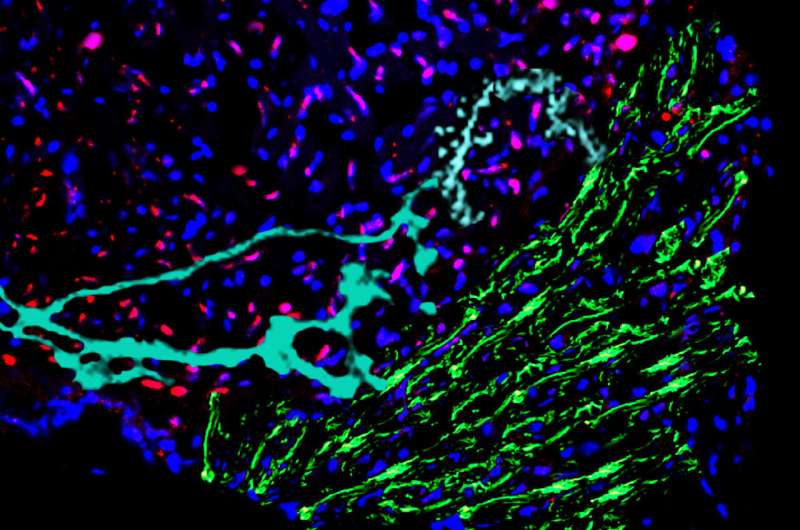This article has been reviewed according to Science X's editorial process and policies. Editors have highlighted the following attributes while ensuring the content's credibility:
fact-checked
peer-reviewed publication
trusted source
proofread
Zebrafish study demonstrates heart repair via neuroimmune crosstalk

Unlike humans, zebrafish can completely regenerate their hearts after injury. They owe this ability to the interaction between their nervous and immune systems, as researchers led by Suphansa Sawamiphak from the Max Delbrück Center now report in the journal Developmental Cell.
Each year, more than 300,000 people in Germany have a myocardial infarction—the technical term for heart attack. The number of people surviving a heart attack has increased significantly, but this severe cardiac event causes irreparable damage to their hearts. A heart attack occurs when blood vessels that supply blood and oxygen to the heart muscle become blocked, causing part of the heart muscle tissue to die.
This damage is permanent because the human heart has no ability to grow new heart muscle cells. Instead, connective tissue cells known as fibroblasts migrate into the damaged area of the heart muscle. They form scar tissue that weakens the pumping power of the heart. Previous attempts to use stem cells to treat infarction-damaged hearts have not been very successful.
The team led by Dr. Suphansa Sawamiphak, head of the Cardiovascular-Hematopoietic Interaction Lab at the Max Delbrück Center, is looking at the process from a different angle.
"We know that both signals from the autonomic nervous system and the immune system play a pivotal role in scarring and regeneration," says Sawamiphak. "So it stands to reason that the communication between the autonomic nervous and immune systems determines whether heart muscle scarring will occur or whether the heart muscle can recover." It is also known that macrophages play a role in both processes. But how is this decision made?
To address this question, the researchers are studying zebrafish larvae. The fish can be easily modified and are also optically transparent, making internal processes easy to observe in the living organism. "Plus, they can fully regenerate their heart after an injury," says Onur Apaydin, first author of the study published in Developmental Cell.
The researchers used zebrafish larvae whose heart muscle cells produce a fluorescent substance, making it easy to detect them under a microscope. They then induced an injury similar to a myocardial infarction in the larval hearts and blocked several receptors on the surface of the macrophages. The result was that adrenergic signals from the autonomic nervous system determined whether the macrophages multiplied and migrated into the damaged site. These signals also played an important role in regenerating heart muscle tissue.
In the next step, the researchers engineered genetically modified zebrafish in which the adrenergic signal reached the macrophages but could not be transmitted from the receptor into the cell's interior. "This showed that signal transmission is crucial for heart regeneration," says Apaydin. If signaling is interrupted, the scarring process is triggered instead.
"Our findings indicate that this is a key regulator of crosstalk between the nervous and immune systems," says Apaydin. When macrophages are activated by the adrenergic signals of the autonomic nervous system, they in turn communicate with fibroblasts. Fibroblasts that promote regeneration alter the extracellular matrix at the damaged site.
This ultimately creates a microenvironment conducive to the growth of blood and lymph vessels and the development of new heart vessels. If, on the other hand, the signal is blocked, fibroblasts infiltrate the site and cause scarring—similar to what occurs in the human heart after a heart attack.
"We next want to examine in detail how signaling differs between zebrafish and humans," says Sawamiphak. "This will help us understand why heart muscle tissue is unable to regenerate in humans." The team also hopes to identify potential targets for influencing the interaction between the nervous and immune systems in a way that promotes the regeneration of heart muscle tissue and the maintenance of heart function in heart attack patients.
More information: Onur Apaydin et al, Alpha-1 adrenergic signaling drives cardiac regeneration via extracellular matrix remodeling transcriptional program in zebrafish macrophages, Developmental Cell (2023). DOI: 10.1016/j.devcel.2023.09.011



















